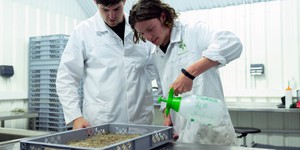Abstract
This project uses liquid cultures and agar plates to investigate the effects of different concentrations of a food preservative on microbial growth.Summary
Andrew Olson, Ph.D., Science Buddies
Sources
- Youssefian, A., 2003. How Do Additives Affect the Growth of Microorganisms? California State Science Fair Abstract. Retrieved September 20, 2006.
Objective
The purpose of this project is to determine the effective concentration for anti-microbial food preservatives.
Introduction
The problem of protecting food from spoilage has been with us since prehistoric times. The solutions to this problem have changed with advances in technology and knowledge about what causes food to spoil. This project will focus on retarding microbial growth, which is only one of the causes of food spoilage.
There are many ways that food can be spoiled. For example, oils in food can become oxidized, releasing free fatty acids that cause a bitter, rancid taste. Additionally, natural enzymes that take part in the ripening process of fruits and vegetables can remain active after harvest, causing spoilage. Different chemical preservatives have been developed to counteract each of these different mechanisms: "Preservatives can be categorized into three general types: antimicrobials that inhibit growth of bacteria, yeasts, or molds; antioxidants that slow air oxidation of fats and lipids, which leads to rancidity; and a third type that blocks the natural ripening and enzymatic processes that continue to occur in foodstuffs after harvest." (Dalton, 2002)
In order for an antimicrobial preservative to work, it must be used at the right concentration. Ideally, it will disrupt microbial growth while at the same time preserving most of the nutritional value of the food.
To do this project, you should first do background research on methods of food preservation. Then, select an antimicrobial preservation method to test for your experiment. As an example, this project will test one of the oldest preservation methods by adding different concentrations of salt.
Terms and Concepts
To do this project, you should do research that enables you to understand the following terms and concepts:
- bacteria,
- conditions for bacterial growth,
- minimum, maximum, and optimum values for temperature, pH, osmolarity.
- preservatives,
- food additives,
- food preservation.
Questions
- What is meant by "effective concentration" for a chemical compound?
- What are the effective concentrations for the additives you intend to test?
Bibliography
- This article provides a general overview for methods of food preservation:
Brain, M., date unknown. How Food Preservation Works, HowStuffWorks.com. Retrieved September 20, 2006. - These articles provide an introduction to the different types of food preservatives, and what each is used for:
- Dalton, L., 2002. "What's That Stuff? Food Preservatives: Antimicrobials, Antioxidants, and Metal Chelators Keep Food Fresh," Chemical & Engineering News, American Chemical Society 80 (45): 40, available online. Retrieved September 20, 2006.
- Foulke, J.E., 1998. A Fresh Look at Food Preservatives, FDA Consumer, U.S. Food and Drug Administration. Retrieved August 29, 2013.
- This webpage has background information on nutritional requirements for bacterial growth. It is from an online textbook of bacteriology, which can be an excellent source of further information on bacteria:
Todar, K., 2002. Nutrition and Growth of Bacteria, Todar's Online Textbook of Bacteriology, Department of Bacteriology, University of Wisconsin, Madison. Retrieved September 20, 2006.
Materials and Equipment
To do this experiment you will need the following materials and equipment:
- 4 low-salt chicken boullion cubes
- 500 mL hot water
- 10 glass jars with lids
- anti-microbial preservative; for example, you could try one of the following:
- salt
- sugar
- vinegar
- electronic balance, such as the Fast Weigh MS-500-BLK Digital Pocket Scale, 500 by 0.1 G, available from Amazon.com
- masking tape
- marking pen
- disposable gloves. Can be purchased at a local drug store or pharmacy, or through an online supplier like Carolina Biological Supply Company. If you are allergic to latex, use vinyl or polyethylene gloves.
- inoculating loop. Sterile, disposable inoculating loops are available from Carolina Biological Supply Company. Alternatively, although it is less preferable, sterile cotton-tipped applicators (e.g., Q-tips from an unopened box) may be used instead. Sterile cotton-tipped applicators are also available from Carolina Biological Supply Company. Note: If you are not using sterile, disposable inoculating loops or applicators, but are using a metal loop instead, you will also need a bunsen burner to flame the loop.
- 40 nutrient agar plates. These are available from Carolina Biological Supply Company.
Disclaimer: Science Buddies participates in affiliate programs with Home Science Tools, Amazon.com, Carolina Biological, and Jameco Electronics. Proceeds from the affiliate programs help support Science Buddies, a 501(c)(3) public charity, and keep our resources free for everyone. Our top priority is student learning. If you have any comments (positive or negative) related to purchases you've made for science projects from recommendations on our site, please let us know. Write to us at scibuddy@sciencebuddies.org.
Experimental Procedure
For health and safety reasons, science fairs regulate what kinds of biological materials can be used in science fair projects. You should check with your science fair's Scientific Review Committee before starting this experiment to make sure your science fair project complies with all local rules. Many science fairs follow Regeneron International Science and Engineering Fair (ISEF) regulations. For more information, visit these Science Buddies pages: Project Involving Potentially Hazardous Biological Agents and Scientific Review Committee. You can also visit the webpage ISEF Rules & Guidelines directly.
- Dissolve 2 chicken broth cubes in 500 mL of hot water.
- Divide the solution into 10 glass jars (50 mL/jar).
- Following the table, add preservative at 4 different concentrations, and add nothing for the control condition. Make two replicates of each condition 10 jars total). Be sure that the salt you add is fully dissolved.
Label Amount Broth (mL) Amount Salt (g) Control 50 0 #1 2.5% 48.75 1.25 #2 5% 47.5 2.5 #3 10% 45 5.0 #4 20% 40 10 - If you use a preservative other than salt, you should do background research to come up with an estimate of the effective concentration. Make the effective concentration your #3 test condition. Condition #'s 1, 2, and 4 should be 1/4, 1/2, and 2 times this concentration, respectively.
- Take samples on 1st, 3rd, 5th and 7th days, and streak onto agar plates. To streak the agar plates, put on disposable gloves and use the inoculating loop (or sterile cotton-tipped applicator) to perform the quadrant streaking method (Inoculation: How to Put the Bacteria You Desire on a Petri Dish). Note: If you are using disposable loops or applicators, you will not need to use a bunsen burner to flame them since they should already be sterile.
- Be sure to properly label all plates with the test solution and day number.
- Tape plates closed, incubate (inverted) overnight, and count bacterial colonies.
- Does the number of colonies decrease as concentration of the preservative increases?
Bacterial Safety
Bacteria are all around us in our daily lives and the vast majority of them are not harmful. However, for maximum safety, all bacterial cultures should always be treated as potential hazards. This means that proper handling, cleanup, and disposal are necessary. Below are a few important safety reminders.
- Keep your nose and mouth away from tubes, pipettes, or other tools that come in contact with bacterial cultures, in order to avoid ingesting or inhaling any bacteria.
- Make sure to wash your hands thoroughly after handling bacteria.
- Proper Disposal of Bacterial Cultures
- Bacterial cultures, plates, and disposables that are used to manipulate the bacteria should be soaked in a 10% bleach solution (1 part bleach to 9 parts water) for 1–2 hours.
- Use caution when handling the bleach, as it can ruin your clothes if spilled, and any disinfectant can be harmful if splashed in your eyes.
- After bleach treatment is completed, these items can be placed in your normal household garbage.
- Cleaning Your Work Area
- At the end of your experiment, use a disinfectant, such as 70% ethanol, a 10% bleach solution, or a commercial antibacterial kitchen/bath cleaning solution, to thoroughly clean any surfaces you have used.
- Be aware of the possible hazards of disinfectants and use them carefully.
Ask an Expert
Global Connections
The United Nations Sustainable Development Goals (UNSDGs) are a blueprint to achieve a better and more sustainable future for all.
Variations
- Compare refrigerated and/or frozen vs. room-temperature broth.
- Try additional preservatives. What are their effective concentrations?
- Try preservatives with solid food, e.g., salt meat or pickled vegetables. See the Science Buddies project, Minimizing Bacteria in the Thawing and Cooking of Meat for a method of pureeing solid food in order to assess bacterial content. Be sure to establish baseline bacterial content by pureeing samples before treatment with preservatives.
- Compare starting sterile vs. not. If you have a pressure cooker, here is an experiment you can try. Follow canning procedures for three jars. For the other three, use normal conditions for cooking and left-over food storage in three separate jars. Test by plating samples from successive jars from each condition at 1 day, 1 week, 2 weeks.
Careers
If you like this project, you might enjoy exploring these related careers:
Related Links
- Science Fair Project Guide
- Other Ideas Like This
- Microbiology Project Ideas
- My Favorites
- All About Agar
- Interpreting Plates
- Inoculation: How to Put the Bacteria You Desire on a Petri Dish
- Microbiology Techniques & Troubleshooting
- Microorganisms Safety Guide











